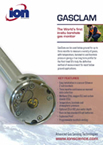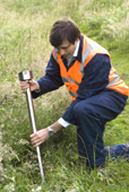GasClam Continuous Borehole Monitor
Continuous 24/7 data collection for Former Landfill and Brownfield Sites
Collection of comprehensive data can speed up site development for housing or commercial use
Proves the long-term quality of gas produced for power generation from landfill sites
Battery operated miniature design In-Borehole Landfill Gas Monitor
Please Click here for full details on pdf

|
 |
GasClam In-Borehole Landfill Gas Analyser gives an accurate view of landfill site gas release activity.
We measured flow because this was the only tool we had. But now we have progressed. Flow can vary by the hour, but the continuous measurement offered by GasClam with Barometric and Borehole pressure shows the true picture of what is happening below ground. Collection of comprehensive data can speed up site development.
Purchase or hire GasClam from Shawcity Limited
See this White Paper on
Continuous Ground-Gas Monitoring |
 |
Techniques for Landfill Gas Monitoring
Surface monitoring is used to check the integrity of caps on waste sites and check on borehole monitoring. It may give preliminay indications of the migration of gas off-site. The typical regulatory limit of methane is 500 parts per million (ppm) by volume (in California, AB 32 may push this limit down to 200 ppm). In the UK the limit for a final landfill cap is 1*10-3 milligrams per square metre per second, and for a temporary cap it is 1*10-1 mg/m2/s ( as measured using the Environment Agency's " Guidance on Landfill Gas Monitoring surface emissions " LFTGN 07, EA 2004 ). Surface Landfill Gas Monitoring can be broken down into Instantaneous and Integrated. Instantaneous Landfill Gas Monitoring consists of walking over the surface while carrying a flame ionization detector (FID). Integrated consists of walking over the surface while pumping a sample into a bag. The sample is then read with a FID or sent to a lab for full analysis. Integrated regulatory limits tend to be 50 ppm or less.
Landfill Gas Monitoring Gas probes, also known as perimeter or migration probes, are used for Subsurface monitoring and detect gas concentrations in the local environment around the probe. Sometimes multiple probes are used at different depths at a Single point. Probes typically form a ring around a Landfill. The distance between probes varies but rarely exceedes 300 metres. The typical regulatory limit of methane here is 50,000 parts per million (ppm) by volume, or 1% methane and 1.5% carbon dioxide above geological background levels in the UK ( see " Guidance on the monitoring of Gas " LFTGN03, EA 2004).
Ambient air samplers are used to monitor the air around for excessive amounts of methane and other gases. The principal odoriferous compounds are hydrogen sulfide ( which is also toxic ) and the majority of a population exposed to more than 5 parts per billion will complain ( World Health Organisation : WHO (2000) as well as volatile organic acids. Air quality guidelines for Europe, 2nd ed. Copenhagen, World Health Organization Regional Publications, European Series).
Monitoring of the gas itself can be used diagnostically. When there is concern regarding the possibility of an ongoing subsurface oxidation event, or fire, the presence in the gas of compounds that are more stable at the high temperatures of such an event ( above 500 deg C ) can be evidence for such a process occurring. The presence of propene, which can be formed from propane at temperatures above several hundred degrees C, supports high temperatures. The presence of elevated concentrations of dihydrogen (H2) in the gas is also consistent with elevated temperatures at remote locations some distance from the gas-extraction well. The presence of H2 is consistent with thermal inactivation of CO2-reducing microbes, which normally combine all H2 produced by fermentation of organic acids with CO2 to form methane ( CH4 ). H2-producing microbes are less temperature-sensitive than CO2-reducing microbes so that elevated temperatures can inactivate them and their recovery can be delayed over the H2-producers. This can result in H2 production without the (usually )corresponding consumption, resulting in elevated concentrations of H2 in the gas (up to >25%v:v at some sites). Thermal deactivation of CO2-reducing microbes has been used to produce CO2 (rather than methane) from municipal solid waste (Yu, et al., 2002).
Portable or Continuous Single or Multi Gas Monitoring Instruments
Portable handheld Single or Multi Gas Monitor Instruments detect multiple gases and keep workers safe. We provide quality Single or Multi Gas Monitor Instruments and multi-gas detectors. Shop online for Multi Gas Monitor Instruments and Multi gas detectors, these handheld Portable Single or Multi Gas Monitor Instruments are built with the durability and simplicity found in every instrument. They are reliable low cost Single or Multi Gas Monitor solution for confined space or personal Gas Monitoring applications. |